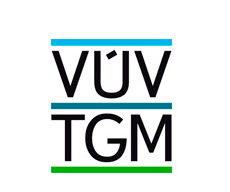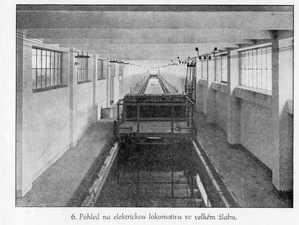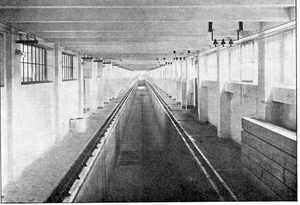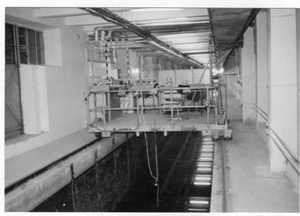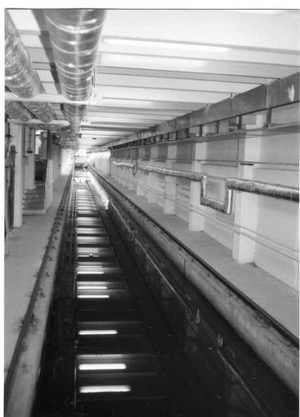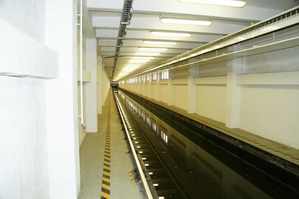History
History of calibration of hydrometric instruments in our Institute dates from the moment when the new building of then the State Research Institute of Water Structures at Prague-Podbaba beside of the navigational canal of the Troja weir in 1930 was opened. Since then, the calibration of current meters and other similar instruments is a continuous activity which the Institute offers to its customers.
It should be said here that the first calibration tank of modern concept was built by R. A. Harlacher, of Swiss origin, professor of the Prague Technical University, in Prague Vltava River port in 1875. The tank had rail track of length of 80 m on which a manually driven rating carriage moved. Then, calibration stations at Vienna and Bern, which were equipped by special tanks, were put into operation in 1896. Before our calibration station started operation, most of current meters used at our country were calibrated at Vienna.
A big hydraulic tank of width of 2.5 m is a basic part of our calibration laboratory. Total usable length is a little shorter than the overall length of the middle segment – 138.6 m and water depth is about 1.8 m (one of the biggest European ones). It was built in the framework of construction of a new building of the T. G. Masaryk State Research Institute of Water Structures, which was brought into service in 1930. The tank is fed by water from the Vltava River. Constant water level is ensured by bilateral weir at the entrance part of the tank. The tank can be closed by vertical sluice gates at its entrance and outlet so that the water within the tank is entirely still. Along both sides of the tank, tracks with straight leveled rails are laid. On these tracks, this self-propelled rating carriage runs. The carriage is primarily used for current meter calibration, but can be used e.g. for experiments with towed bodies (as ship hulls) in a still water in order to determine their drag forces, and for other purposes as well. From the total usable length of the tank, only its central part about 100 m long is used for calibrations. The tank, or more precisely its structural part, has not almost changed since the time of its building, but its equipment, especially the rating carriage, did changed quite radically.
The original carriage was made by the well-known Českomoravká-Kolben-Daněk (ČKD) corporation in 1930. The carriage had electric propulsion with speed regulation by two-stage transmission gear and regulation of motor revolutions by Ward-Leonard aggregate. The carriage speed could be chosen in the range of 0.02 to 6.0 m/s. As a registration device, a three-channel chronograph, recording impulses that register a covered distance, time, and number of impulses from the current meter on a paper strip, was used [1].
This first carriage was replaced by more up-to-date carriage, constructed by the German enterprise Kempf-Roemmers in 1962. The speed control and the speed range were the same as of the original carriage. In the second half of the 60s, the registration system completely changed – the original three-channel chronograph was replaced by a digital electronic apparatus developed in the Institute by Věkoslav Sotorník (Czechoslovak patent no. 127621). This apparatus enabled simultaneous data acquisition from three current meters. A basic contribution of this new digital system was, in addition to a significant simplification of data processing, the possibility to choose a number of impulses from every meter and the determination of covered distance using metal strip with holes at mutual distances of 0.05 m with an optoelectronic mark sensing. This distance measuring system proved itself to be so good and reliable that it is used in a modified form up to these days. Revolution and distance counters of distance impulses were electromechanical. A quartz clock with a time resolution of 0.01 s was used as a time base [2]. Because the electronic apparatus was a quite bulky and needed adequate temperature and humidity for its trouble-free operation it was located in control room beside the tank. Data transmission from the carriage to the control room was executed wirelessly by a low power transmitter.
In the course of time the electronic device was worn out. Especially the electromechanical counters exceeded their lifespan. This was manifested by frequent malfunctions, so a radical solution of this state was urgently needed. In 1987, Josef Zaujec from the Department of Measuring Technology and Electronics of the Institute designed, constructed and put a new data acquisition device, which was on the basis of 8-bit industrial computer SAPI-1, into operation under supervision of the head of the department Pavel Čížek [3]. This device was effective and this prototype was continuously improved until a tragic death of its author. But the issue of processing the calibration data, which, in addition, had to be copied from a TV set used as a monitor, persisted and the data were still processed by a semi-graphical method.
With an introduction of computers of the PC class, an automated data processing was implemented in 1991. The computer program was developed by Petr Šnederfler. It was a mighty progress against the original graphical-numerical evaluation of calibration equations. On the second hand, transfer of the data from the monitor to a form and then from the form to the computer brought an increased possibility of a formation of errors and this work system was very inefficient.
Moreover, the data acquisition device based on SAPI-1 quickly became outdated with the development of computers of the PC class. The rating carriage also reached the end of its lifespan and its maintenance was pretty difficult. Because of that, a complete innovation of the calibration station equipment was considered. The reconstruction had to include a new digitally controlled carriage and automated data acquisition with consecutive evaluation of calibration equations. Financial funds for the reconstruction were successfully acquired and proposal of the solution was designed in 1995.
Design of the new carriage and its manufacturing including control and data acquisition systems were carried out by the company DICONT a.s., a small Czech joint-stock company. Regarding not very friendly conditions in the tank space especially during winter season, it was possible to control the new carriage not only directly, but also remotely from the control room. Data transmission between the carriage and the control room was arranged by optoelectronic IR components. Custom software for automated data processing was carried out by the Roman Škára - Software & Hardware company. The carriage was installed in December 1996. The new equipment was put into regular operation after successful testing in February 1997.
The Institute applied by the Czech Accreditation Institute for accrediting the CCSCM as calibration laboratory, because parameters of the new equipment reached top level. CCSCM was successfully accredited in 1997.
The Institute was hit by a catastrophic flood in 2002 resulting in total devastation of all premises and equipment of the calibration station. Particular tank was damaged only slightly, but whole equipment as well as voluminous archive was unfortunately lost.
New and improved carriage with appropriate electronics for its control and data acquisition was supplied again by the DICONT a.s. Connection of the carriage with the control room is now ensured through Wi-Fi. Because in the framework of the reconstruction, the control room was moved one floor higher above the level of the 100-year flood, the tank premises was equipped by a camera system enabling visual control of the whole tank and the carriage under automated remote control operation. The new equipment was put into the operation in January 2005 after successful testing. During tank reconstruction, a provision for evacuation of the carriage, the most expensive part of the equipment, from the tank to a roof of the Institute’s boiler house in a case of flood threat was made. Until now, the last action, a general repair of the tracks rails including their rectification and grinding, was done in December 2006.
[1] Smetana, J.: Státní výzkumný ústav hydrotechnický T. G. Masaryka. Jeho účel, vznik a zařízení. Práce Státního výzkumného ústavu hydrotechnického T. G. Masaryka č. 1. Státní ústav hydrologický, Praha 1930.
[2] Sotorník, V.: Cejchování hydrometrických vrtulí. Vodní hospodářství, řada A, 1975, č. 8, s. 220–223.
[3] Because of the flood in 2002 resulting at total loss of the calibration laboratory archive, the data in this paragraph are based on recollection of memories of the former employees so that they may be somewhat loose.


